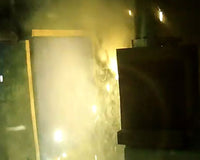What is ELIM?
ELIM, which stands for "Energy Limit Value," is a term used in the context of arc flash testing and electrical safety. It represents a conservative approach to determining the protective capabilities of materials and clothing against the hazards of an arc flash event. An arc flash is a sudden release of electrical energy through the air, which can result in intense heat, light, sound, and pressure, potentially causing severe injuries or even fatalities.
ELIM in Arc Testing
In arc flash testing, ELIM is defined as the maximum incident energy value that a material or clothing can withstand without any of its responses (such as temperature rise or material integrity) exceeding the Stoll Curve, which represents a certain level of injury risk. Additionally, ELIM ensures that the material or clothing does not break open under the given energy exposure. In other words, ELIM signifies the threshold below which all responses of the material or clothing remain within safe limits, providing a higher degree of protection for workers.
How is ELIM Calculated?
Calculating ELIM involves a systematic process that considers the incident energy levels generated during arc flash testing. ELIM is a more conservative measure compared to traditional arc flash testing parameters and is designed to provide a comprehensive safety threshold for materials and clothing. Here's how ELIM is calculated in relation to arc testing:
-
Gather Data Points: To calculate ELIM, a set of incident energy data points is collected during arc flash testing. These data points represent the energy levels to which the material or clothing is exposed during controlled testing scenarios.
- Determine the Mix Zone: The mix zone refers to the range of incident energy levels between the lowest energy level that crosses the Stoll Curve (ATPV) and the highest energy level that does not. This range is crucial because it encompasses the transitional region where some materials might breach the protective threshold while others remain intact.

-
Calculate the Average: ELIM is calculated by averaging the incident energy levels within the mix zone. This average value represents the Incident Energy Limit Value, which is the threshold below which all product responses are expected to remain below the Stoll Curve and without material breakopen.
-
Striving for Comprehensive Protection: The calculated ELIM value offers a more conservative estimate of protective capabilities compared to traditional arc flash testing parameters like APTV. By considering both the potential for injuries (represented by the Stoll Curve) and the risk of material breakopen, ELIM provides a comprehensive safety benchmark.
How does ELIM Differ from ATPV & EBT?
Compared to traditional arc flash testing parameters like APTV (Arc Thermal Performance Value) and EBT (Exposed Breakopen Threshold), ELIM sets a more cautious standard for safety. APTV indicates the incident energy level at which a fabric has a 50% probability of causing second-degree burns, while EBT denotes the energy level at which a fabric breaks open due to an arc flash. ELIM combines these aspects, striving for protection beyond burn injury or material breakage.
Why does some Arc Flash Clothing have an ELIM & ATPV Value?
Arc flash clothing with both ELIM and values provides a more comprehensive understanding of the clothing's protective capabilities in various scenarios. These two values serve different purposes and address different aspects of safety as mentioned above. Here's why some arc flash clothing has both ELIM and ATPV values:
-
Well rounded Safety Evaluation:
ELIM and ATPV values offer different perspectives on protective clothing. ATPV focuses on the thermal insulation capacity of the clothing and its ability to prevent second-degree burns in case of an arc flash incident. On the other hand, ELIM takes a broader approach by considering both injury prevention (as indicated by the Stoll Curve) and material integrity. Having both values ensures that the clothing's protection is evaluated from multiple angles, offering a more comprehensive safety assessment.
-
Adapting For Different Risks & Environments
Work environments can vary greatly in terms of the potential energy levels of arc flash incidents. ELIM and ATPV values provide flexibility for employers to choose the most suitable clothing for their specific environments. Some workplaces might have higher energy potential, necessitating clothing with higher ATPV and ELIM values, while others might require different combinations based on the specific risks involved.
-
Provides Wearers & HSE with Confidence
Providing both ELIM and ATPV values on arc flash clothing labels instils confidence in workers and safety professionals. It demonstrates that the clothing's protection has been evaluated thoroughly and addresses a range of potential hazards, fostering a safer working environment.
Summary
ELIM is a significant advancement in electrical safety, aiming to provide a comprehensive measure of protection against the potential hazards of arc flash incidents. It considers not only the risk of burns and injury but also the integrity of materials, ensuring a higher level of safety for workers in environments where arc flash events could occur.
It's crucial to equip your workforce with the best possible protection against arc flash hazards. With STRATA Protection's in-house brand of Arc FR clothing, you're not just getting garments – you're getting a comprehensive safety solution. Our commitment to your team's well-being is evident in the inclusion of both ELIM and ATPV values in most garments.
Reach out and book a conversation with our Technical Team at sales@skanwear.com to discuss how we can support your business from a protection, compliance, and legal point of view.




